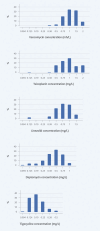Antimicrobial Susceptibility of Various MRSA Clinical Isolates and the Impact of Glycopeptide MICs on Clinical and Microbiological Outcomes
- PMID: 39005705
- PMCID: PMC11243782
- DOI: 10.36519/idcm.2024.330
Antimicrobial Susceptibility of Various MRSA Clinical Isolates and the Impact of Glycopeptide MICs on Clinical and Microbiological Outcomes
Abstract
Objective: While vancomycin has remained the mainstay of the treatment for methicillin-resistant Staphylococcus aureus (MRSA) infections, there is growing evidence of the clinical impact of increased glycopeptide minimum inhibitory concentrations (MICs) in MRSA isolates. This study aimed to determine the susceptibility of various MRSA isolates to different antibiotics with antistaphylococcal activity and the impact of glycopeptide MICs on clinical and microbiological outcomes.
Materials and methods: This retrospective cohort study, conducted between 2013 and 2017, evaluated the susceptibility of MRSA strains isolated from various clinical samples to antistaphylococcal antibiotics using the gradient strip method. The clinical and laboratory features of patients infected with MRSA isolates with elevated glycopeptide MICs (>1 mg/L) and with isolates that had low glycopeptide MICs (≤1 mg/L) were compared.
Results: A total of 104 patients infected with MRSA strains were included in this study. Male sex (odds ratio [OR]=2.48, 95% confidence interval [CI]=1.01-6.10, p=0.048), two or more comorbidities (OR=2.48, 95% CI=1.03-6.50, p=0.044), history of MRSA infection (OR=4.91, 95% CI=1.70-14.28, p=0.003) and a longer hospital stay prior to MRSA infection (OR=2.32, 95% CI=1.05-7.85, p=0.040) were independent risk factors for high glycopeptide MICs. In MRSA infections with a teicoplanin MIC of >0.75mg/L, the microbiological and treatment failures were 46.2% (p=0.044) and 60.6% (p=0.042), respectively.
Conclusion: This study showed that the critical MIC value, which suggested treatment failure as well as microbiological failure in the teicoplanin-treated MRSA infections, was >0.75 mg/L rather than >1 mg/L in our study cohort. The identification of high-risk patients;for treatment failures and mortality considering gradient strip method MIC values is crucial for the effective management of MRSA infections.
Keywords: glycopeptide; gradient strip method; methicillin-resistant Staphylococcus aureus; minimum inhibitory concentration; treatment failure.
Copyright © 2024 Infectious Diseases and Clinical Microbiology.
Conflict of interest statement
The authors declare no conflict of interest.
Figures
References
-
- Tran N, Rybak MJ. β-Lactam combinations with vancomycin show synergistic activity against vancomycin-susceptible Staphylococcus aureus, vancomycin-intermediate S. aureus (VISA), and heterogeneous VISA. Antimicrob Agents Chemother. 2018;62(6):e00157-18. doi: 10.1128/AAC.00157-18. - DOI - PMC - PubMed
-
- Lodise TP, Graves J, Evans A, Graffunder E, Helmecke M, Lomaestro BM, et al. Relationship between vancomycin MIC and failure among patients with methicillin-resistant Staphylococcus aureus bacteremia treated with vancomycin. Antimicrob Agents Chemother. 2008;52(9):3315–3320. doi: 10.1128/AAC.00113-08. - DOI - PMC - PubMed
-
- Chang HJ, Hsu PC, Yang CC, Siu LK, Kuo AJ, Chia JH, et al. Influence of teicoplanin MICs on treatment outcomes among patients with teicoplanin-treated methicillin-resistant Staphylococcus aureus bacteraemia: a hospital-based retrospective study. J Antimicrob Chemother. 2012;67(3):736–741. doi: 10.1093/jac/dkr531. - DOI - PubMed
LinkOut - more resources
Full Text Sources
Molecular Biology Databases

